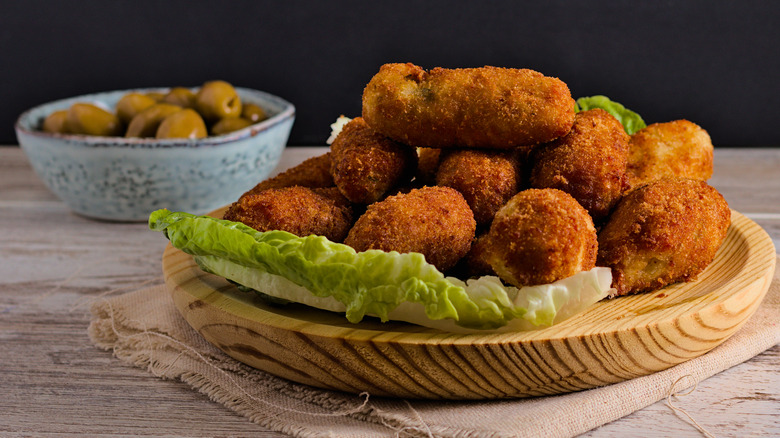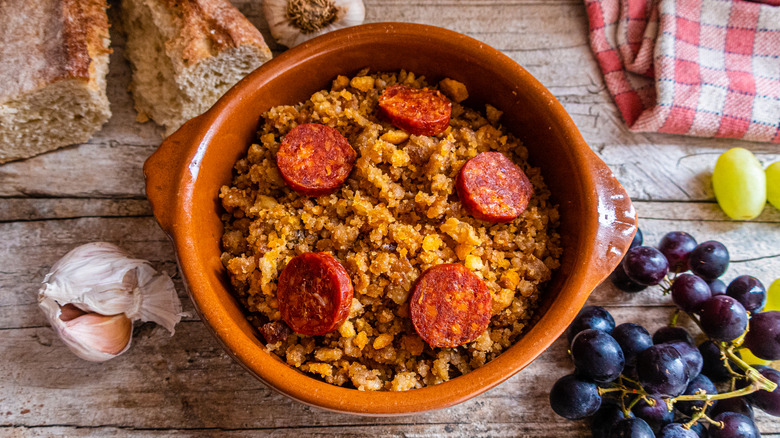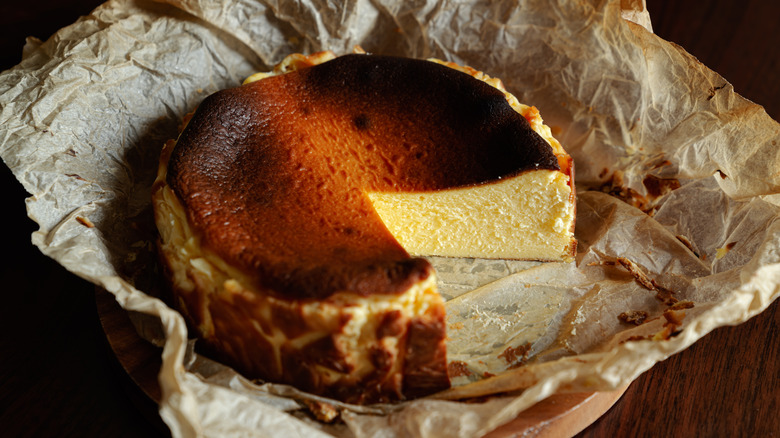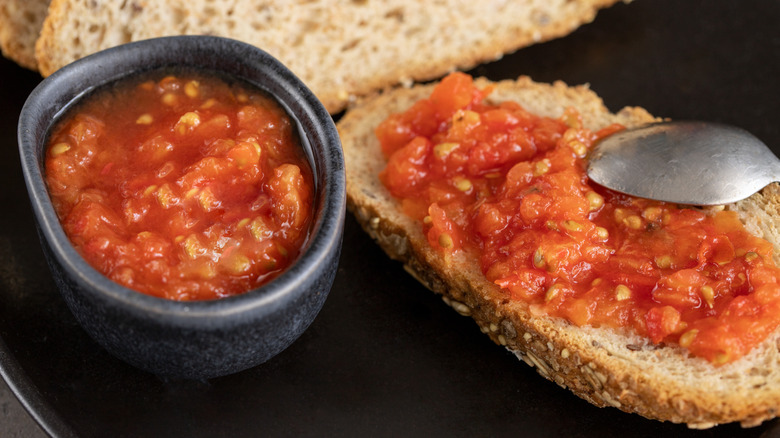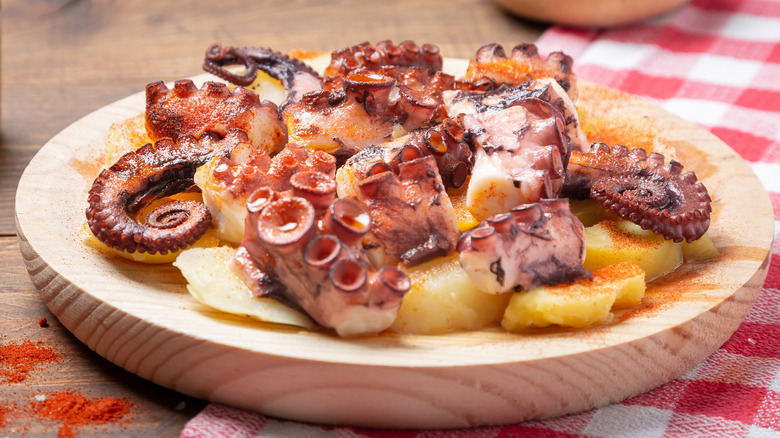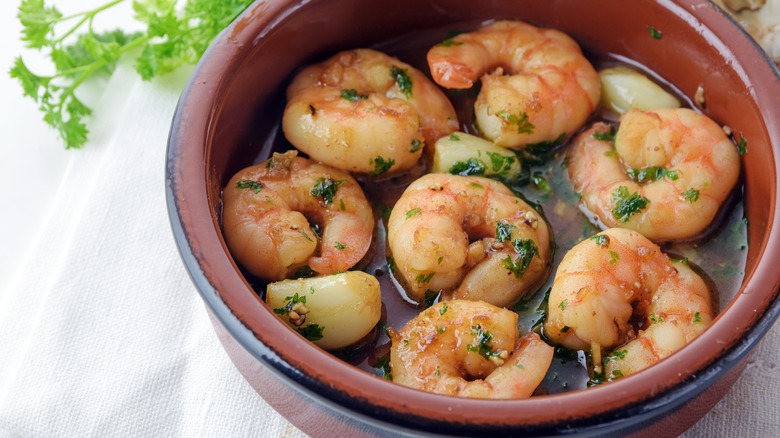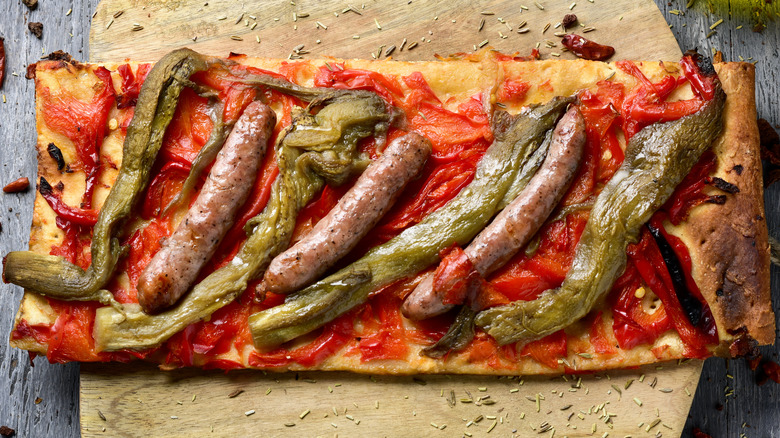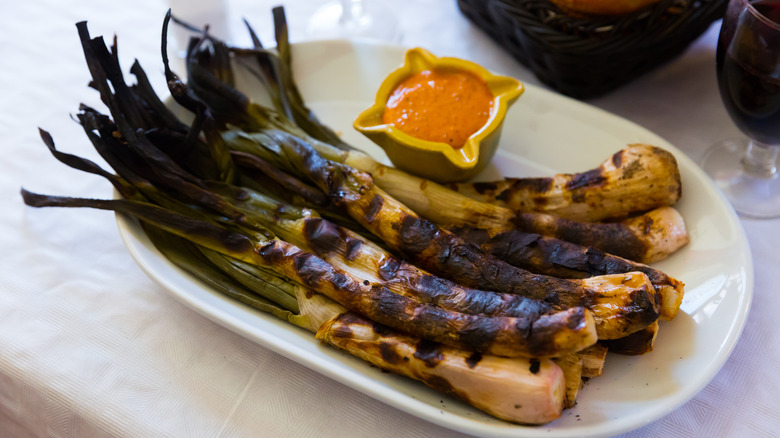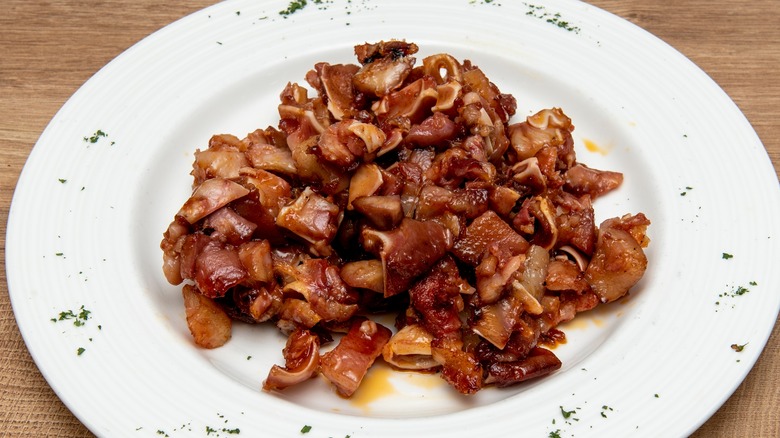29 Spanish Dishes You Need To Try At Least Once
While the cuisine of Spain may not be as well-known stateside as that of its European cousins, Italy and France, it deserves to be. The essence of Spanish cooking technique is taking the fabulous ingredients the country produces, such as its vibrant olive oil, fresh seafood, juicy tomatoes, world-class ham, and doing the bare minimum to transform them into simple, yummy dishes. When the products you're working with are as good as those available to Spanish cooks, doing too much to them is unnecessary, and even disrespectful.
It's kind of a misnomer to say that there is one cuisine called "Spanish food." As we dive into this list, you'll notice that many of these dishes come from distinct areas within Spain, including the Andalucia, Galicia, Catalonia, and Basque regions. Although it's hard to capture the breadth of Spanish regional cuisine in any form shorter than a book, these 20 dishes might be considered the greatest hits.
Paella
Paella is one Spanish dish that most people are already somewhat familiar with. There are many different types of paella, but the original is said to come from Valencia. It dates back to the 18th century (or possibly earlier, but that's where the first written recipe is from). The name comes from the Latin word "patella" and refers to the pan it is cooked on, and often eaten from. However, there's also an alternate theory that the name is derived from the Arabic word for "leftovers."
The original paella Valenciana consisted of duck, chicken, and rabbit, and today, a traditional dish also has tomatoes, rice, and two types of beans cooked together in a saffron-enriched broth over an open fire. A perfectly-cooked paella will have a layer of toasted rice on the bottom of the pan called the socarrat. Although the original paella doesn't have seafood in it, our recipe for Paella mixta uses a delicious mix of shrimp, mussels, clams, chorizo, and chicken with great results.
Croquetas de Jamón
Spanish croquetas are little nuggets of thick béchamel sauce studded with some kind of protein, breaded, and then deep-fried. They can be flavored with different meats, including salt cod, chicken, or the non-traditional (but delicious) choice of bacon, apple, and onions that we have a recipe for. However, if you ask us, the ultimate Spanish croqueta is filled with jamón serrano. It's the perfect combination of creamy béchamel, crispy-fried coating, and salty-savory ham. If you're lucky enough to have some leftover scraps of Serrano ham lying around there's no better use for them.
Croquetas de jamón are served all over Spain and they're a popular choice at tapas bars. If you're fortunate enough to live close to a Spanish restaurant, we recommend checking these out, as they are a perfect light bite to munch on during Happy Hour. Making them at home is more of a hassle, but still worth it if you're not blessed with a nearby tapas bar.
Tortilla Española
If you're thinking that this tortilla has anything to do with the thin flatbread you'll find wrapped around tacos and burritos, think again. A tortilla Española is actually a type of omelet filled with potatoes and onions that have been poached in olive oil. Unlike a skinny, rolled French omelet, a Spanish tortilla is a thick cake of eggs and veggies, somewhat similar to a frittata. However, frittatas cook in the oven, while tortillas cook entirely on the stove in a skillet. In order to cook the tortilla on both sides, you have to execute a tricky flipping maneuver using a plate that requires some practice.
Although tortillas are one of Spain's iconic dishes, potatoes weren't believed to have been commonly eaten in the country until the Spanish conquerors brought them back with them after discovering America. And, the new world crop was initially used as livestock fodder. In fact, potatoes didn't become popular as food for humans until the 1800s, which is when the first written record of the tortilla Espańola appears.
Migas
Migas, like tortilla, is a word that refers to different foods depending on whether you're in Mexico or Spain. The Mexican version of migas cooks fried corn tortilla pieces, veggies, and eggs together into a hearty breakfast. The Spanish version is conceptually similar in that it combines little pieces of bread with miscellaneous ingredients to make a tasty hash, but it's quite different when you get into the specifics.
At base, Spanish migas is a dish of breadcrumbs fried in olive oil. From there, you can take it in any direction you want. Often, the crumbs are combined with some kind of pork product. Spanish chorizo is a great choice, but different regions of Spain use different meats. You can also throw in whatever kind of vegetables suit your taste. Migas is a modular meal, and if you're not worried about being too "authentic," it's a great way to use up stale bread and various odds-and-ends that are lurking in your fridge.
Pintxos
Pintxo is a word that really refers to a variety of dishes. In the Basque region, where the word originates, it's used to describe any small dish eaten as a snack with wine. In the rest of Spain, where such snacks are generically called "tapas," pintxos are specifically the kind of tapa that is served on a skewer.
Despite the vagueness that surrounds what counts as a pintxo, there are some classics that appear frequently. Many types of pintxos center around various kinds of pickles and preserved foods arranged together on skewers. The most famous of these is the pintxo gilda, a combination of preserved anchovy, pickled guindilla pepper, and green olive. Another classic is dates stuffed with blue cheese (the stinkier the better), wrapped in bacon, and roasted. Pintxos served on top of small slices of bread are also popular. You can think of that type as the Spanish version of bruschetta.
Morcilla
Morcilla is a type of sausage made from pig's blood and ground pork. Those are the two necessary ingredients for a sausage to be called morcilla, but other than that, the recipes change dramatically depending on where in the country you're eating. One classic version is flavored with onion and spices and uses rice as a filler. Other versions skip the fillers entirely or use pine nuts, potatoes, or squash instead. The seasoning mix also varies regionally, with some areas of Spain preferring a paprika-heavy flavor profile and others leaning on cinnamon and cloves. Seville even has a variety that's sweet.
One of the most classic ways to eat morcilla is also the simplest: cut into thick coins, fried in olive oil, and served on top of bread. You can also use morcilla to flavor soup, stews, and other dishes. Its flavor is intense, unique, and delicious, so if you've never had any kind of blood sausage before, morcilla is a good place to start.
Basque cheesecake
Basque "burnt" cheesecake was quite popular online for a while. Although some internet food trends are more aesthetic than they are delicious, if anything, Basque cheesecake is the opposite; its carbonized exterior and overall lumpy look aren't exactly Instagrammable. Nevertheless, this dessert, which was invented by the pintxos bar La Viña in San Sebastián, a city in Spain's Basque region, went thoroughly viral.
The good news is, you can make Basque cheesecake at home using our recipe without springing for plane tickets to Spain. Even better, this variety of cheesecake is easier to make than American New York-style cheesecake. You don't have to make a crust and you don't have to do any sort of fussy baking technique to prevent the top from cracking. In fact, you basically burn it in the oven, and the crunchy exterior serves as the crust. You only need six ingredients to whip this up, so there's really nothing stopping you from giving this a try. It's as tasty as its reputation would suggest.
Pan con tomate
One of the things Spanish food is great at is making mind-blowingly delicious dishes from the simplest components. No dish highlights that better than pan con tomate (also known as pa amb tomaquet in Catalan). At its simplest, pan con tomate is just a slice of robust bread rubbed with a clove of garlic and a cut tomato, then drizzled with olive oil. It's a great way to showcase the intense flavor of a ripe, in-season tomato. If you want more tomato in your pan con tomate, you can also grate the tomato on a box grater and spread the pulp on a slice of bread, perhaps seasoning it with sherry vinegar and garlic.
Pan con tomate can serve as the base for a variety of tapas by topping it with other ingredients. One typical variation adds some brininess and salt to the mix in the form of anchovy fillets.
Ham
Just about every culture that eats pork makes some kind of ham, but the ham produced in Spain may be the very best in the world. Both major types of Spanish ham, Ibérico and Serrano, are made using the same basic process: coating fresh pork in salt, then hanging it to cure. Traditionally, ham cured out in the open air, but in modern times it's usually processed in specialized facilities that recreate ideal ham-curing weather.
Serrano is the more common and less expensive of the two varieties. It's made using conventional pork breeds that aren't native to Spain. However, it's cured in the traditional manner and aged for at least one year, so it still tastes amazing. The gold standard of Spanish ham is Ibérico, particularly Ibérico bellota. Ibérico is Spain's native pig breed, and it's notable for having a higher fat content than conventional pork. Ibérico hams are also cured for at least two years, so they have a very complex flavor. The best of the best, Ibérico bellota, is made with pigs that are fattened on acorns.
Boquerones en vinagre
Boquerones is Spanish for anchovies. If the only anchovies you've ever had are the tiny, brown, salt-cured variety found on American pizza, you should try Spanish-style boquerones sometime. While they eat the small salt-cured ones in Spain as well, fresh anchovies are also quite popular. You can even find dishes that combine both salted and fresh anchovy fillets for a double dose of fishy umami. Fresh anchovies are larger and meatier than what you might be used to and don't have the intense salt kick that the preserved ones do.
Two of the most popular ways to eat fresh boquerones are fried in olive oil or pickled in vinegar. Boquerones en vinagre, as the latter preparation is called, actually "cook" in their acidic marinade, much in the same way as ceviche. The anchovies marinate in vinegar, and once they turn white, they get submerged in olive oil and garlic. After they're fully cured, they're great all by themselves, but they're even better on top of some nice bread.
Tarta de Santiago
The tarta de Santiago is a traditional cake that has been eaten for centuries and features a dense texture and lemon flavor. In honor of the Feast of St. James, plenty of this cake is consumed in honor of the late saint. Although it's a religious holiday that draws thousands of pilgrims from around the world, it's also a big party with lots of revelry, drinking, and eating. In addition to the tarta de Santiago, it's also traditional to eat oysters and scallops during the festivities.
Because of its role in the Santiago celebration, a true tarta de Santiago must be decorated with the image of the Cross of St. James in powdered sugar. If you thought that gluten-free dessert recipes were a new trend, you might be surprised to find out that the tarta de Santiago is completely gluten-free, as it's made with almond flour instead of wheat. The trick to making the cake light and fluffy is to beat the eggs and almond flour together for a long time. Other than those components, the cake is flavored simply with lemon and sugar.
Pulpo gallego
Pulpo Gallego is another Galician favorite, though now you can find it across Spain. The Spruce Eats' recipe for this dish only has five ingredients, so it's a great way to start exploring Spain's cuisine at home (if you're able to get your hands on octopus, anyway). Even if you're not familiar with cooking octopus, this dish is pretty hard to screw up.
To make it, you simply boil a whole octopus until it's cooked through. Unlike other seafood like squid and shrimp, octopus tastes bests when it's cooked for a long time (if it's not cooked long enough, you'll end up chewing on it forever). Depending on the size of the octopus, you'll probably have to boil it for at least an hour. Once the octopus is done, you slice it into bite-size pieces and garnish it with boiled sliced potatoes, olive oil, salt, and paprika. Like so many simple Spanish dishes, this recipe relies on using the best possible ingredients. You need excellent olive oil and strong paprika to make pulpo Gallego taste the way it should.
Patatas bravas
With the possible exception of the tortilla Española, patatas bravas are Spain's greatest achievement in the realm of potato cookery. They're basically the country's version of a loaded french fry. Instead of long, thin slices of potato as you would use for fries, you traditionally use square-ish chunks to make bravas, but other than that, the procedure is the same. However, you will first fry the potatoes through on a skillet and later fry their exterior. If you want to be extra-Spanish, you should use olive oil to fry the potatoes.
The thing that turns the patatas into patatas bravas is the sauce, which is a thick, slightly spicy condiment flavored with hot paprika. We would also heartily recommend adding a drizzle of garlicky aioli to the mix. This not only gives you a pleasant red-and-white color scheme but also provides a pleasingly creamy contrast to the heat of the bravas sauce.
Gambas al ajillo
It's hard to argue with garlicky shrimp. It's even harder to say no when the shrimp in question are drowning in a deep pool of olive oil. That's what you'll get whenever you order gambas al ajillo from a tapas bar in Spain. The classic way to cook Spanish garlic shrimp is in a clay vessel called a cazuela. You heat up a ton of olive oil in the cazuela and toss in, at the very minimum, garlic and shrimp. If you'd like to get a little fancier, you can add some combination of chili pepper, parsley, bay leaf, sherry vinegar, or brandy, but the simple alchemy of garlic, oil, and shrimp is delicious all on its own.
The tastiest part of this dish isn't even the shrimp themselves (though they are wonderful). No, the best bites come after you have finished the shrimp and you start soaking chunks of bread in the garlic and seafood-scented olive oil. That oil is truly divine.
Gazpacho
Other than paella, gazpacho is probably the first food that comes to mind when you think about Spanish cuisine. While in the U.S. you might immediately think of gazpacho as cold tomato soup, tomatoes are actually not original to the dish. Tomato gazpacho is certainly popular in Spain these days, but the original dish consisted of bread, salt, garlic, vinegar, olive oil, and water combined into a cold slurry. In addition to red tomato gazpacho, there is also a green variety made with herbs and green vegetables like peppers and lettuce.
Our favorite type of gazpacho is the white kind known as ajo blanco. This takes the basic bread gazpacho formula from ancient times and adds ground almonds to the mix, producing a creamy, refreshing soup. A simple garnish of cold grapes turns this into an ideal appetizer or light lunch for a hot summer day.
Bocadillos
A bocadillo is just a Spanish sandwich. They're generally made on a baguette-like type of bread called barra de pan. Anything tasty in Spanish cuisine could become a bocadillo filling, from a slice of tortilla to boquerones to fried calamari to thinly-sliced jamón. While Taste Atlas notes that sometimes the bread can be turned into pan con tomate and other toppings like cheese and olives can join the party, oftentimes bocadillos feature just one filling put into bread with no condiments or other accouterments.
Although such a simple sandwich might sound kind of boring if you're used to complex creations loaded with sauces and condiments, a bocadillo is all about appreciating one impeccably-prepared ingredient in its pure form. If you're eating really good jamòn serrano, you don't necessarily want many other flavors fighting with the delicious ham. The same goes for the freshly-fried calamari tucked into Madrid's famous calamari bocadillos.
Escalivada
The word escalivada is Catalan for "to roast in the embers." Escalivada refers to roasted vegetables that are peeled and dressed with olive oil and sometimes sherry vinegar after they're done cooking. You can use any number of vegetables in this preparation, but eggplant, peppers, and onions are classic. You can eat escalivada with bread as a snack or tapa, but it's also a great side dish for pretty much any type of protein. Although it's made with cooked vegetables, it's usually served at room temperature like a salad. When prepared this way, the vegetables develop a silky, unctuous texture, particularly the eggplant.
Although many roast their escalivada in the oven, we can say from personal experience that this dish tastes even better when cooked over a wood or charcoal fire. The smoke adds depth you just can't achieve in the oven.
Coca
A coca can be many different things, sweet or savory. The basic formula of a coca is to top dough with something flavorful and bake it in the oven. The savory version is very similar to pizza, though the dough is more like a fluffy focaccia dough. Typical toppings for savory coques include butifarra (a type of Spanish sausage), caramelized onions, olives, and boquerones. Unlike pizza, coca is generally served at room temperature instead of piping hot.
Sweet coques start with a different dough from the savory ones. It's more pastry-like, with a flaky lightness derived from the addition of butter or lard. One classic combo for sweet coques is anisette (an anise-flavored liqueur), sugar, and pine nuts. If anise isn't your thing, citrus-toped coques are also popular. Really, the coca form accepts a multiplicity of toppings, so you can make them however you want to.
Calçots in romesco
Romesco sauce is a creamy mixture of pureed dried peppers, almonds and/or hazelnuts, garlic, olive oil, and sherry vinegar that's thickened with bread. Although you can make versions of romesco with a variety of peppers, the authentic pepper is the ñora, a deep-red dried chile from Spain. Sometimes the ñoras are blended with bell peppers or piquillos, but that's far from universal.
Romesco comes from the town of Tarragona, where it is typically used as a condiment for grilled calçots. Calçots are a special variety of onion, and they were traditionally eaten in spring, although they are now grown throughout the year.
Since calçots are hard to find in the U.S., you can serve your romesco with grilled scallions or spring onions if you would like. You don't have to limit yourself to onions either; This sauce tastes fantastic on anything that's hot off the grill, and it's wonderful with fish as well.
Mejillones en escabeche
Escabeche is a generic term for any kind of food that is either steamed or fried before being cooked or left to marinate in a brine. It was originally a way to preserve ingredients, but now it is done simply for its flavor. The word comes from the Arabic term for vinegar stew, suggesting that the dish has Moorish origins.
Many different ingredients can be prepared in the escabeche style, including various types of poultry and seafood. One of the most typical escabeches is done with mejillones, which translates to mussels in English. To make mejillones in escabeche, you first have to cook the mussels by steaming them and then remove them from their shells. Next, you submerge the shucked mussels in a brine made from olive oil, wine, vinegar, garlic, and spices. If you want to honor the dish's history and preserve your escabeche, you can put it in canning jars to keep it on the shelf in your pantry.
Pisto
Often compared to its ratatouille cousin in France, pisto is a Spanish vegetable stew made up of savory eggplant, a medley of green and red peppers, juicy tomatoes, and olive oil. Similar in origin to paella, pisto can be traced back to Spain's Moorish era when the recipe is thought to have been developed for the wedding of a Moorish princess in the coastal region of Murcia.
The magic happens in the broth — or rather, the lack thereof. Pisto's hearty stew consistency comes together with a generous glug of olive oil and the natural moisture in the vegetables that simmer low and slow until all their natural flavors ooze out. Enjoy pisto with slivers of manchego cheese on top, aka pisto manchego. Serve it with fried eggs at breakfast or feast on it as a main course. Either way, you'll find it easy to see why this authentic Spanish dish is quite literally fit for royalty.
Pimientos de padrón
Salty, slightly sweet, and scorched in extra virgin olive oil, pimientos de padrón are one of Spain's most authentic and beloved tapas recipes. Found all over the country in buzzing tapas taverns and elsewhere, this delicious classic comes together with just padrón peppers, olive oil, and a generous dash of sea salt. Wash them down with an ice-cold cerveza.
Just remember that eating pimientos de padrón is a game of chance. Most of the time, the charred and generously salted peppers have a bold yet mild flavor — sometimes though, the heat level can pack a serious punch. There's an old saying that goes, "¡Pimientos de padrón, unos pican y otros non!" Or in English, "Padrón peppers, some are hot and some are not!" These petite, emerald-colored peppers made their way to Spain's Galicia region via Franciscan monks who were returning to the Iberian Peninsula from Latin America in the 16th century. Whatever their origin, for centuries, pimientos de padrón have been a staple on the Spanish table.
Fideuà
Hailing from Valencia, Spain, Fideuà is made up of short, thin noodles that simmer in a rich fish broth with a mix of seafood and generous sprinkles of saffron to create the funky, lesser-known cousin of region's famous paella. It's also a dish made for feasting and is rarely ever prepared for a single serving, so it's the perfect sharing dish — even split between two people, you'll still want to come hungry.
Fideuà is as legendary as it is tasty. According to Eater, one origin story says that a cook who was manning a kitchen on a fishing boat was trying to make paella but ran out of rice, so he tossed in some fideus noodles instead. Needless to say, the dish was a hit with the other sailors and quickly took off. This delightfully gluttonous dish is typically dressed up with a nice squeeze of lemon or a generous dollop of aioli, a creamy, garlicky condiment whose roots lie somewhere between Provence, France, and Catalonia, Spain.
Queso de cabrales
There's blue cheese, and then there's queso de cabrales, a delightfully pungent artisan cheese made in the rural mountainous region of Asturias in northwest Spain. Queso de cabrales is a traditional blue cheese cured deep in the wilds of Picos de Europa, a vast series of silver limestone peaks whose caves provide the perfect amount of humidity for aging fine cheeses. Rural farmers of the region use a blend of cow, sheep, and/or goat's milk that gives the cheese its distinct, strong flavor and high-fat content.
Because it has such a strong flavor, it's best to balance it with something sweet, like figs, honey, or a glass of sherry. All things considered though, there's no better pairing than the region's other beloved specialty: Asturian cider. To enjoy more than just a couple of crumbles of queso de cabrales, feast on solomillo al cabrales, a comforting regional dish of seared beef tenderloin smothered in queso de cabrales and generously seasoned with thyme and olive oil.
Navajas al ajillo
Navajas al ajillo is a must-try when it comes to Spanish seafood tapas. This zesty marisco dish is made up of clams, garlic, fresh herbs, and just the right amount of white wine and olive oil for the ultimate indulgence. While you can enjoy navajas al ajillo in plenty of coastal (and non-coastal) places around Spain depending on the season, Catalonia does them best. Don't forget to enjoy a heaping plate of them with a bubbling glass of cava, the region's answer to Champagne.
These tapas aren't just any type of clam either: Navajas are razor clams. Clocking in at about 5-6 inches long on average, razor clams are known for their distinct shape, delicate shell, and subtly sweet flavor. Because of their odd shape and unique burrowing patterns, these clams are also notoriously difficult to harvest when compared with other shellfish and are often exclusively hand-caught. Admittedly, this doesn't help their price tag, but the freshness of the navajas al ajillo with the savory aromatics of garlic and herbs make the splurge worthwhile.
Oreja a la plancha
When most people think of Spain and pork, melt-in-your-mouth slivers of delicate, burgundy-hued jamón Ibérico usually come to mind. And don't get us wrong, jamón Iberico is certainly in a league of its own. Just don't miss out on oreja a la plancha, a traditional pork tapa from Madrid with a main ingredient you don't see praised all that often: pig's ears.
Consisting of sliced or cubed pig ears grilled in olive oil and spices, oreja a la plancha is humble and absolutely delicious. They are crunchy on the outside, soft on the inside, and have the occasional chewiness of cartilage that really only adds to the uniqueness of this Spanish classic. Not ready to have them by themselves just yet? Opt for oreja en salsa, the same dish, but stewed in a rich tomato sauce. While you're at it, grab a pint of the other Madrid favorite, Mahou Cinco Estrella, a blonde beer perfect for washing down one of the city's most beloved delicacies.
Callos a la madrileña
Often compared to menudo found in Mexican and Filipino cuisines, callos a la madrileña is a hearty stew that showcases beef tripe and, as its name suggests, is originally from Madrid where it's been served for time immemorial. Cooked for hours on low heat, the broth itself makes callos a la Madrileña the ultimate comfort food with its rich, beefy flavor and thick consistency.
While the tripe, or callos, is certainly the star of the show, callos a la Madrileña also incorporates a medley of other tasty Spanish delights that help earn its reputation as one of the cuisine's most authentic and flavorful dishes. Medallions of rich morcilla and liberally spiced chorizo, coupled with cow trotters, delicate honeycomb beef tripe, and the occasional pig snout or oxtail, all work together to give callos a la Madrileña its flavor. While typically served as a tapas dish in old-school tavernas all across the capital and beyond, many Spanish restaurants also offer it as a main dish.
Fabada asturiana
Asturians have been cultivating and consuming beans for 500 years, and Fabada Asturiana, a tasty bean stew native to the region, has been around for about as long. One of the highlights of Fabada Asturiana is that it is traditionally prepared using "fabes de la granja" beans, a type of Asturian faba bean loved for its smooth texture that makes for velvety, filling dishes.
Not to be confused with fava beans, Asturian faba beans are very large, similarly shaped to cannellini beans, and have a subtle buttery flavor that helps take dishes next level. Native to the lush meadows that double as the region's riverbanks, Asturian faba beans also have their own Denomination of Protected Origin (D.O.P), an EU recognition with the same caliber as Parmigiano Reggiano in Italy and Kalamata olives in Greece. Not to mention, the stew is also loaded with other mouthwatering ingredients like pork shoulder, chorizo, and morcilla, which in Asturias, is smoked rather than dried.
Albondigas
From keftedes to köttbullar, and klopsiki to bola-bola, meatballs are loved around the world. And in Spain, they're known as albondigas. Like so many other Spanish dishes, albondigas rely solely on simple, flavorful ingredients. The juicy pork and beef meatballs themselves are flavored with onions, garlic, and parsley, and their binding is usually rice or bread.
The meat is only half of the experience though; the rest of the dish comes together once the meatballs have simmered in a lush tomato sauce with hints of smoked paprika and fiery chili flakes. It's perfect for dipping a fresh, warm slice of bread into. Albondigas take their name from al-bunduq — an Arabic word meaning "hazelnut" or, in this context, a small, round object — placing albondigas' origin during Spain's Moorish era in Andalusia. While it's possible to have albondigas as a main dish, it's traditionally prepared as a tapa. Whichever your choice, pair them with a cold beer or a bold tempranillo to really get the full experience.


